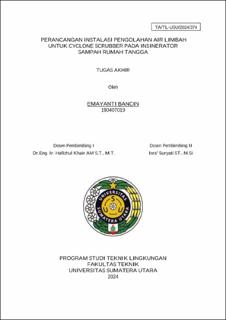| dc.description.abstract | The integration of Sustainable Development principles and Sustainable Development
Goals (SDGs), especially SDG 6 on Clean Water and Sanitation, is important in
incinerator operations. The use of technologies such as cyclone scrubbers can increase
efficiency in reducing air pollutants but has an impact on increasing the use of water
resources. This research is a follow-up study that aims to design a cyclone scrubber
wastewater treatment plant for household waste incinerators. In this research, there are
several stages of the process carried out, starting with literature studies from various
journals, testing the quality of incinerator wastewater, and designing a wastewater
treatment system. Therefore, specific treatment actions are needed to ensure that the
resulting waste meets the environmental quality standards set. The selected treatment
alternatives consist of wastewater storage tanks, with dimensions reaching 24 cm in
height and 36.5 cm in diameter. For the second stage coagulation tank, flocculation
tank, and sedimentation tank. The coagulation tank has a height of 30 cm and width and
length of 21 cm each, while the flocculation tank has a height of 25 cm, width of 21 cm,
and length of 36 cm. The sedimentation tank has dimensions with a height of 30 cm,
width of 25 cm, and length of 50 cm; the GAC adsorption tube has dimensions with a
building height of 31 cm and a diameter of 23 cm. After the treatment process is
complete, the treated water is stored in clean water storage tanks with dimensions of 25
cm in height, 57 cm in width, and 68 cm in length. | en_US |


